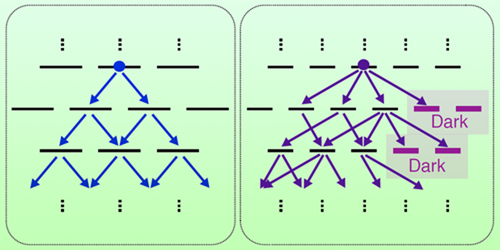Multilevel Atoms Go Dark
When atoms interact collectively with a light field, they can emit light at a greater rate than they would if they acted independently. These collective interactions can also induce the opposite effect, suppressing photon emission such that the ensemble enters a dark state. Such “subradiant” states have been created in dense atomic ensembles of two-level atoms, and they have been predicted in ensembles of multilevel atoms. Asier Piñeiro Orioli and colleagues, at the University of Boulder, Colorado, have now calculated how these collective atom-light interactions play out for multilevel atoms in an optical cavity [1]. The team predicts that multilevel atoms in a cavity are surprisingly easy to coax into subradiant states.
The atoms that Piñeiro Orioli and colleagues consider have complex electronic structures because of their multiple degenerate ground states and multiple degenerate excited states. When the atoms are trapped in an optical cavity, each atom interacts—via the cavity’s electromagnetic field—with every other atom equally, such that their internal electronic states can become entangled.
The team’s calculations predict that, after being coherently driven by a laser tuned to both the cavity’s resonant frequency and the electronic transition frequency of the atoms, as many as half of the atoms can get “stuck” in an excited state. Relaxation is then inhibited because of interference effects between photons emitted by different atoms and via different internal transitions.
The team says that their predictions could be tested using clouds of alkaline-earth atoms trapped in an optical lattice within a cavity. They also suggest that such a system could find use in quantum sensing applications, where, for example, the dark state’s ability to store phase information for extended periods might improve the performance of atomic clocks.
–Marric Stephens
Marric Stephens is a Corresponding Editor for Physics Magazine based in Bristol, UK.
References
- A. Piñeiro Orioli et al., “Emergent dark states from superradiant dynamics in multilevel atoms in a cavity,” Phys. Rev. X 12, 011054 (2022).




